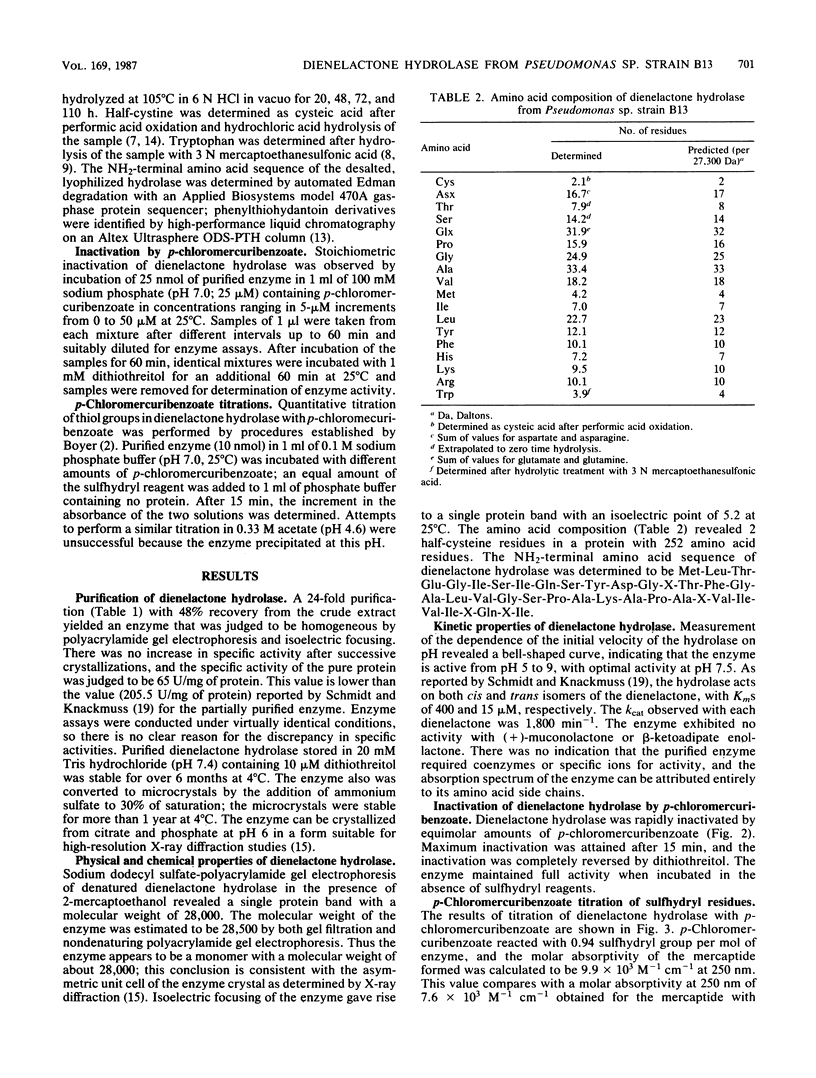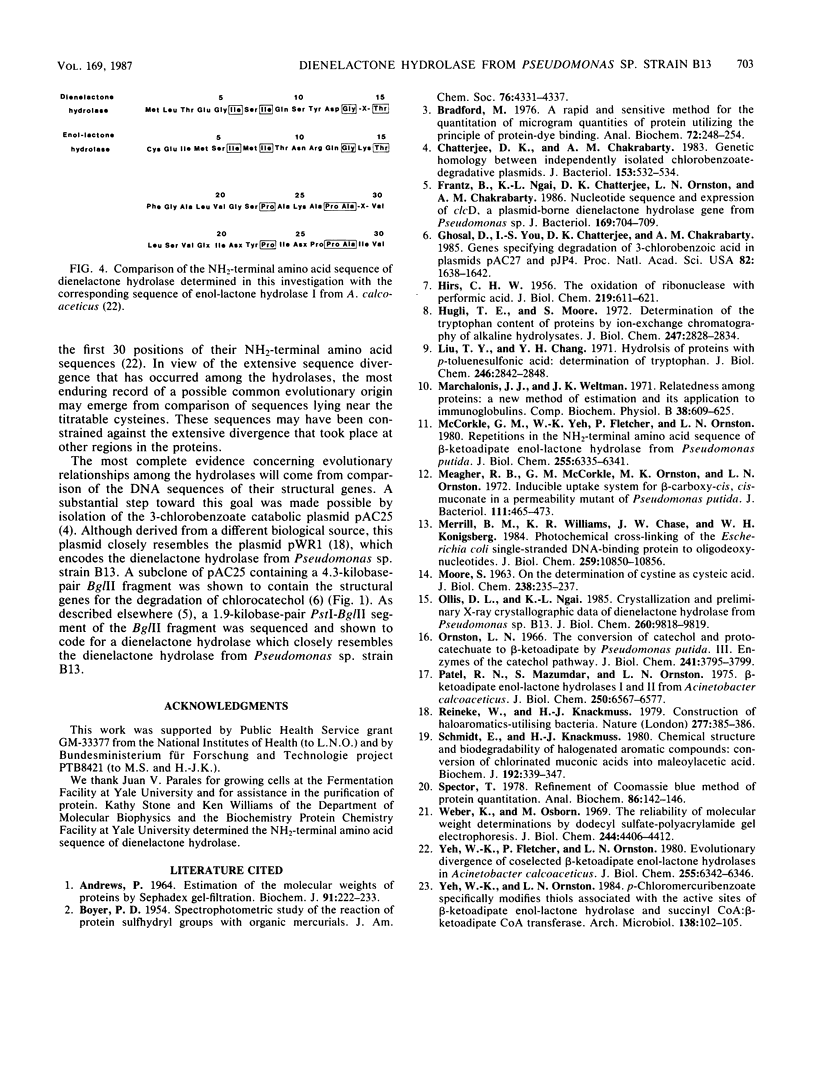Abstract
Dienelactone hydrolase (EC 3.1.1.45) catalyzes the conversion of cis- or trans-4-carboxymethylenebut-2-en-4-olide (dienelactone) to maleylacetate. An approximately 24-fold purification from extracts of 3-chlorobenzoate-grown Pseudomonas sp. strain B13 yielded a homogeneous preparation of the enzyme. The purified enzyme crystallized readily and proved to be a monomer with a molecular weight of about 30,000. Each dienelactone hydrolase molecule contains two cysteinyl side chains. One of these was readily titrated by stoichiometric amounts of p-chloromercuribenzoate, resulting in inactivation of the enzyme; the inactivation could be reversed by the addition of dithiothreitol. The other cysteinyl side chain appeared to be protected in the native protein against chemical reaction with p-chloromercuribenzoate. The properties of sulfhydryl side chains in dienelactone hydrolase resembled those that have been characterized for bacterial 4-carboxymethylbut-3-en-4-olide (enol-lactone) hydrolases (EC 3.1.1.24), which also are monomers with molecular weights of about 30,000. The amino acid composition of the dienelactone hydrolase resembled the amino acid composition of enol-lactone hydrolase from Pseudomonas putida, and alignment of the NH2-terminal amino acid sequence of the dienelactone hydrolase with the corresponding sequence of an Acinetobacter calcoaceticus enol-lactone hydrolase revealed sequence identity at 8 of the 28 positions. These observations foster the hypothesis that the lactone hydrolases share a common ancestor. The lactone hydrolases differed in one significant property: the kcat of dienelactone hydrolase was 1,800 min-1, an order of magnitude below the kcat observed with enol-lactone hydrolases. The relatively low catalytic activity of dienelactone hydrolase may demand its production at the high levels observed for induced cultures of Pseudomonas sp. strain B13.
Full text
PDF




Selected References
These references are in PubMed. This may not be the complete list of references from this article.
- Andrews P. Estimation of the molecular weights of proteins by Sephadex gel-filtration. Biochem J. 1964 May;91(2):222–233. doi: 10.1042/bj0910222. [DOI] [PMC free article] [PubMed] [Google Scholar]
- Bradford M. M. A rapid and sensitive method for the quantitation of microgram quantities of protein utilizing the principle of protein-dye binding. Anal Biochem. 1976 May 7;72:248–254. doi: 10.1016/0003-2697(76)90527-3. [DOI] [PubMed] [Google Scholar]
- Chatterjee D. K., Chakrabarty A. M. Genetic homology between independently isolated chlorobenzoate-degradative plasmids. J Bacteriol. 1983 Jan;153(1):532–534. doi: 10.1128/jb.153.1.532-534.1983. [DOI] [PMC free article] [PubMed] [Google Scholar]
- Frantz B., Ngai K. L., Chatterjee D. K., Ornston L. N., Chakrabarty A. M. Nucleotide sequence and expression of clcD, a plasmid-borne dienelactone hydrolase gene from Pseudomonas sp. strain B13. J Bacteriol. 1987 Feb;169(2):704–709. doi: 10.1128/jb.169.2.704-709.1987. [DOI] [PMC free article] [PubMed] [Google Scholar]
- Ghosal D., You I. S., Chatterjee D. K., Chakrabarty A. M. Genes specifying degradation of 3-chlorobenzoic acid in plasmids pAC27 and pJP4. Proc Natl Acad Sci U S A. 1985 Mar;82(6):1638–1642. doi: 10.1073/pnas.82.6.1638. [DOI] [PMC free article] [PubMed] [Google Scholar]
- HIRS C. H. The oxidation of ribonuclease with performic acid. J Biol Chem. 1956 Apr;219(2):611–621. [PubMed] [Google Scholar]
- Hugli T. E., Moore S. Determination of the tryptophan content of proteins by ion exchange chromatography of alkaline hydrolysates. J Biol Chem. 1972 May 10;247(9):2828–2834. [PubMed] [Google Scholar]
- Liu T. Y., Chang Y. H. Hydrolysis of proteins with p-toluenesulfonic acid. Determination of tryptophan. J Biol Chem. 1971 May 10;246(9):2842–2848. [PubMed] [Google Scholar]
- McCorkle G. M., Yeh W. K., Fletcher P., Ornston L. N. Repetitions in the NH2-terminal amino acid sequence of beta-ketoadipate enol-lactone hydrolase from Pseudomonas putida. J Biol Chem. 1980 Jul 10;255(13):6335–6341. [PubMed] [Google Scholar]
- Meagher R. B., McCorkle G. M., Ornston M. K., Ornston L. N. Inducible uptake system for -carboxy-cis, cis-muconate in a permeability mutant of Pseudomonas putida. J Bacteriol. 1972 Aug;111(2):465–473. doi: 10.1128/jb.111.2.465-473.1972. [DOI] [PMC free article] [PubMed] [Google Scholar]
- Merrill B. M., Williams K. R., Chase J. W., Konigsberg W. H. Photochemical cross-linking of the Escherichia coli single-stranded DNA-binding protein to oligodeoxynucleotides. Identification of phenylalanine 60 as the site of cross-linking. J Biol Chem. 1984 Sep 10;259(17):10850–10856. [PubMed] [Google Scholar]
- Ollis D. L., Ngai K. L. Crystallization and preliminary x-ray crystallographic data of dienelactone hydrolase from Pseudomonas sp. B13. J Biol Chem. 1985 Aug 15;260(17):9818–9819. [PubMed] [Google Scholar]
- Ornston L. N. The conversion of catechol and protocatechuate to beta-ketoadipate by Pseudomonas putida. 3. Enzymes of the catechol pathway. J Biol Chem. 1966 Aug 25;241(16):3795–3799. [PubMed] [Google Scholar]
- Patel R. N., Mazumdar S., Ornston L. N. Beta-ketoadipate enol-lactone hydrolases I and II from Acinetobacter calcoaceticus. J Biol Chem. 1975 Aug 25;250(16):6567–6567. [PubMed] [Google Scholar]
- Reineke W., Knackmuss H. J. Construction of haloaromatics utilising bacteria. Nature. 1979 Feb 1;277(5695):385–386. doi: 10.1038/277385a0. [DOI] [PubMed] [Google Scholar]
- Schmidt E., Knackmuss H. J. Chemical structure and biodegradability of halogenated aromatic compounds. Conversion of chlorinated muconic acids into maleoylacetic acid. Biochem J. 1980 Oct 15;192(1):339–347. doi: 10.1042/bj1920339. [DOI] [PMC free article] [PubMed] [Google Scholar]
- Spector T. Refinement of the coomassie blue method of protein quantitation. A simple and linear spectrophotometric assay for less than or equal to 0.5 to 50 microgram of protein. Anal Biochem. 1978 May;86(1):142–146. doi: 10.1016/0003-2697(78)90327-5. [DOI] [PubMed] [Google Scholar]
- Weber K., Osborn M. The reliability of molecular weight determinations by dodecyl sulfate-polyacrylamide gel electrophoresis. J Biol Chem. 1969 Aug 25;244(16):4406–4412. [PubMed] [Google Scholar]
- Yeh W. K., Fletcher P., Ornston L. N. Evolutionary divergence of co-selected beta-ketoadipate enol-lactone hydrolases in Acinetobacter calcoaceticus. J Biol Chem. 1980 Jul 10;255(13):6342–6346. [PubMed] [Google Scholar]
- Yeh W. K., Ornston L. N. p-Chloromercuribenzoate specifically modifies thiols associated with the active sites of beta-ketoadipate enol-lactone hydrolase and succinyl CoA: beta-ketoadipate CoA transferase. Arch Microbiol. 1984 Jun;138(2):102–105. doi: 10.1007/BF00413008. [DOI] [PubMed] [Google Scholar]


